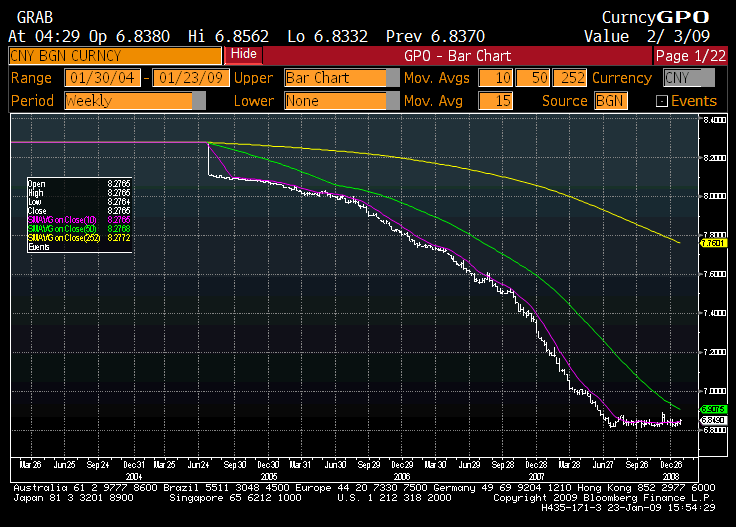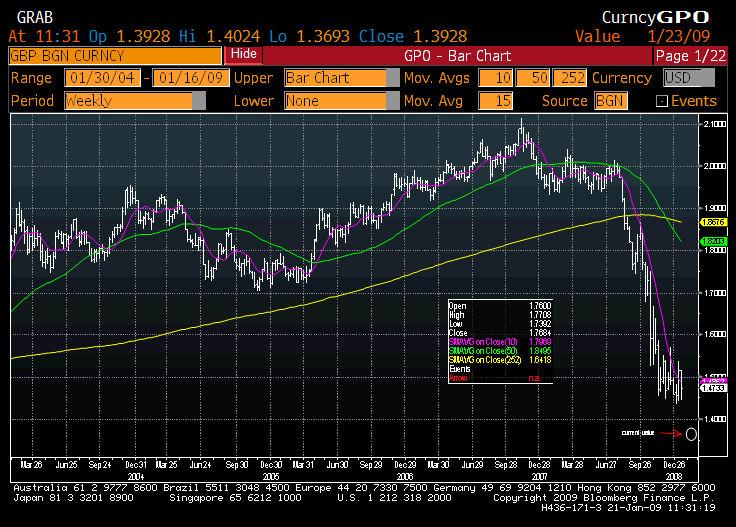The March FOMC Statement
Below you will see my summary of the FOMC Statement and how it changed.? Before I give you that, let me summarize what I think the changes are, the market impact, and whether I think it will work.
The Changes
- The Fed will expand its balance sheet massively, buying another $750 billion of agency mortgage-backed securities, $300 billion of long Treasuries, another $100 billion of Agencies, and expand eligible collateral for the TALF to include who knows what.
- The crisis involves the real economy in a big way now, not just the financial economy.
- The crisis is definitely global.
- They have ceased to forecast when it will end.
- They are pursuing recovery, not growth now.
The Market Impact
- The Dollar fell roughly 2-3%.? Gold rallied 4%+.
- The ten-year sector of the nominal Treasury curve fell the most in yield terms, around 50 basis points. Biggest rally since 1962.? The long end fell 30 basis points. Agencies outperformed Treasuries.? Mortgages lagged.
- TIPS outperformed nominal bonds with the long end falling 40 basis points, and the 10-year 55 basis points, leading inflation expectations to rise.
Will this work?
I?m skeptical.? This is just a bigger shift of financial obligations from the balance sheet of financials to the Fed, at prices unfavorable to the Fed, because their own statements will make them buy dearly.? When they unwind these trades, they will take significant losses, eliminating seniorage income to the US Treasury.
Lowering Treasury, Agency and conforming mortgage rates, assuming that it can be done in the long run (not likely), will not help consumers or corporations.? Forcing a small spectrum of interest rates down does little for collateral values.? People are inverted on their debts, and this does not solve that.? You might get a few refinances out of that, but that?s all.? Credit card, auto, and other debts are unaffected, and the TALF is still pie-in-the-sky.? Can it work?? Corporate bonds, bank debt, Commercial real estate loans, etc. ? there is no effect.? It only makes life better for the US Government, Fannie, Freddie, the FHLB, and those seeking conforming mortgage loans.
There is no real debt reduction here, and debt levels are the cause of this crisis, not interest rates on the debt.? I don?t think this will work, but this is another case where ?the beatings will continue until morale improves.?? Ben Bernanke is too certain of what is the correct move, given his Ph.D. studies.? It would be better and simpler to follow an inflationary course that hits at the root causes of debt by giving every adult a $5,000 voucher good to pay off a debt to any regulated financial institution.? Consumers win, banks win, and foreign creditors lose.
Current Recommendation
I don?t think this rally will hold, so when upward momentum fails, sell long duration fixed income positions.
Fed Statements Compared
(I reordered the January Statement to make the compare better.)
|
January 2009
Information received since the Committee met in December suggests that the economy has weakened further. |
March 2009
Information received since the Federal Open Market Committee met in January indicates that the economy continues to contract. |
My Thoughts
Basically the same. |
|
Industrial production, housing starts, and employment have continued to decline steeply, as consumers and businesses have cut back spending. |
Job losses, declining equity and housing wealth, and tight credit conditions have weighed on consumer sentiment and spending. |
There is a hint of deepening of the crisis, especially how falling asset values and diminishing credit affect behavior. |
|
Conditions in some financial markets have improved, in part reflecting government efforts to provide liquidity and strengthen financial institutions; nevertheless, credit conditions for households and firms remain extremely tight. |
Weaker sales prospects and difficulties in obtaining credit have led businesses to cut back on inventories and fixed investment. |
No hint of improving credit now. Lack of credit having real effects on business activity. |
|
Furthermore, global demand appears to be slowing significantly. |
U.S. exports have slumped as a number of major trading partners have also fallen into recession. |
Recession abroad, not merely slowing. |
|
The Committee anticipates that a gradual recovery in economic activity will begin later this year, but the downside risks to that outlook are significant. |
Although the near term economic outlook is weak, the Committee anticipates that policy actions to stabilize financial markets and institutions, together with fiscal and monetary stimulus, will contribute to a gradual resumption of sustainable economic growth. |
No longer forecasting a recovery this year. Near term outlook is weak. |
|
In light of the declines in the prices of energy and other commodities in recent months and the prospects for considerable economic slack, the Committee expects that inflation pressures will remain subdued in coming quarters. |
In light of increasing economic slack here and abroad, the Committee expects that inflation will remain subdued. |
Weakness is widespread and not contained by country or sector. Economic slack is here now, and not prospective. |
|
Moreover, the Committee sees some risk that inflation could persist for a time below rates that best foster economic growth and price stability in the longer term. |
Moreover, the Committee sees some risk that inflation could persist for a time below rates that best foster economic growth and price stability in the longer term.
|
Same |
|
The Federal Reserve will employ all available tools to promote the resumption of sustainable economic growth and to preserve price stability. |
In these circumstances, the Federal Reserve will employ all available tools to promote economic recovery and to preserve price stability. |
No longer are they pursuing growth, but recovery. |
|
The Federal Open Market Committee decided today to keep its target range for the federal funds rate at 0 to 1/4 percent. The Committee continues to anticipate that economic conditions are likely to warrant exceptionally low levels of the federal funds rate for some time. |
The Committee will maintain the target range for the federal funds rate at 0 to 1/4 percent and anticipates that economic conditions are likely to warrant exceptionally low levels of the federal funds rate for an extended period. |
The Fed funds rate, now irrelevant, will stay irrelevant for a long time. |
|
The focus of the Committee’s policy is to support the functioning of financial markets and stimulate the economy through open market operations and other measures that are likely to keep the size of the Federal Reserve’s balance sheet at a high level. The Federal Reserve continues to purchase large quantities of agency debt and mortgage-backed securities to provide support to the mortgage and housing markets, and it stands ready to expand the quantity of such purchases and the duration of the purchase program as conditions warrant. The Committee also is prepared to purchase longer-term Treasury securities if evolving circumstances indicate that such transactions would be particularly effective in improving conditions in private credit markets. |
To provide greater support to mortgage lending and housing markets, the Committee decided today to increase the size of the Federal Reserve’s balance sheet further by purchasing up to an additional $750 billion of agency mortgage-backed securities, bringing its total purchases of these securities to up to $1.25 trillion this year, and to increase its purchases of agency debt this year by up to $100 billion to a total of up to $200 billion. Moreover, to help improve conditions in private credit markets the Committee decided to purchase up to $300 billion of longer-term Treasury securities over the next six months. |
What was a possibility now is coming. If all of it is executed, the Fed?s balance sheet will grow from $1.9 to $3.0 Trillion. Credit easing, the attempt to manipulate key market interest rates using Fed credit, will be the majority of Fed policy now. |
|
The Federal Reserve will be implementing the Term Asset-Backed Securities Loan Facility to facilitate the extension of credit to households and small businesses. |
The Federal Reserve has launched the Term Asset-Backed Securities Loan Facility to facilitate the extension of credit to households and small businesses and anticipates that the range of eligible collateral for this facility is likely to be expanded to include other financial assets. |
TALF, should it get off the ground, will include rasty stuff that we never imagined the Fed would buy. |
|
The Committee will continue to monitor carefully the size and composition of the Federal Reserve’s balance sheet in light of evolving financial market developments and to assess whether expansions of or modifications to lending facilities would serve to further support credit markets and economic activity and help to preserve price stability. |
The Committee will continue to carefully monitor the size and composition of the Federal Reserve’s balance sheet in light of evolving financial and economic developments.
|
This isn?t just a financial markets crisis anymore. It is now affecting almost every part of the business world. |





